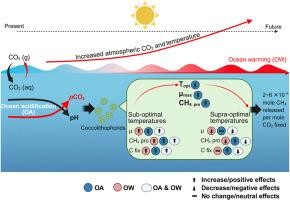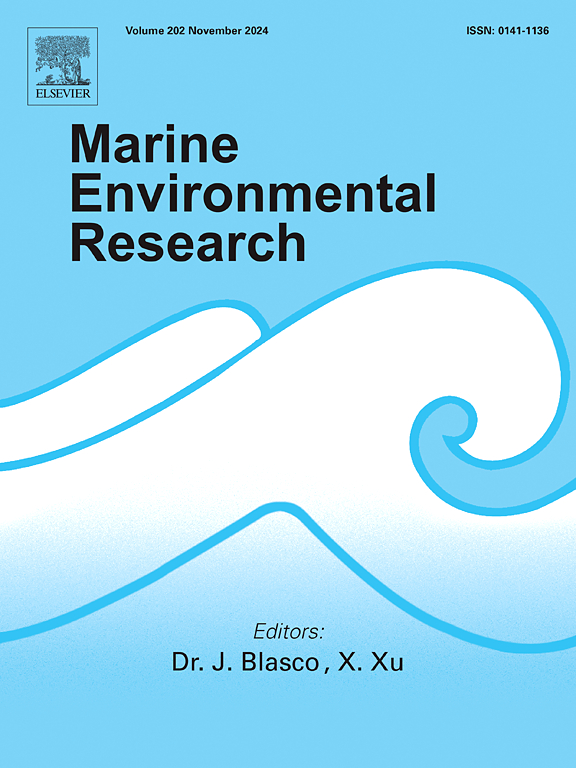Elevated pCO2 and temperature levels modulate the ratios of the photosynthetic methane production to CO2 fixation in the coccolithophorid Emiliania huxleyi
IF 3.2
3区 环境科学与生态学
Q2 ENVIRONMENTAL SCIENCES
引用次数: 0
Abstract
Most phytoplankton species have been shown to release methane (CH4) during photosynthesis; however, little has been documented on how changed levels of CO2 at different temperatures affect their CH4 production along with photosynthetic C fixation. Here, we examined CH4 production and photosynthetic performance in the most cosmopolitan coccolithophorid, Emiliania huxleyi, grown under high (1000 μatm, HC) and ambient (415 μatm, LC) pCO2 levels at five temperatures (16, 20, 22, 24 and 27 °C). The HC treatment slightly lowered the optimal temperature for growth and CH4 production, and temperature changes significantly affected both carbon fixation and CH4 production. Under suboptimal temperatures, increasing temperature from 16 to 20 °C led to about 96 % increase in CH4 production per POC and HC treatment further enhanced this increase by an additional 9 %. In contrast, under super-optimal temperatures, a temperature rise by 4 °C reduced the microalgal CH4 production per POC under HC treatment by about 24 % compared to the control. The calculated CH4 production quotient (MPQ, CH4 released vs. CO2 fixed) ranged between 2 × 10−5−6 × 10−5, and showed a decreasing trend with increasing temperature under both pCO2 levels, implying that the CH4 production by this microalga is being affected by global ocean changes, and the CH4 produced by phytoplankton should be quantified and included in assessing the feedback of marine phytoplankton to climate change.

升高的二氧化碳分压和温度水平调节了球石藻中光合作用甲烷产生与二氧化碳固定的比例。
大多数浮游植物在光合作用过程中释放甲烷(CH4);然而,关于不同温度下二氧化碳水平的变化如何影响它们的CH4生产以及光合作用的碳固定的文献很少。在16、20、22、24和27°C 5种温度条件下,研究了在高(1000 μatm, HC)和环境(415 μatm, LC) co2浓度下生长的最普遍的球石斛(Emiliania huxleyi)的CH4产量和光合性能。HC处理略微降低了生长和产CH4的最适温度,温度变化对固碳和产CH4均有显著影响。在次优温度下,温度从16℃升高到20℃,每POC的CH4产量增加了约96%,HC处理进一步提高了9%。相比之下,在超优温度下,与对照相比,温度每升高4°C, HC处理下微藻每POC的CH4产量减少约24%。计算得到的CH4产商(MPQ, CH4释放vs. CO2固定)在2 × 10-5-6 × 10-5之间,且在两种pCO2水平下均随温度升高呈下降趋势,表明该微藻的CH4产量受到全球海洋变化的影响,应将其量化并纳入海洋浮游植物对气候变化的反馈评估中。
本文章由计算机程序翻译,如有差异,请以英文原文为准。
求助全文
约1分钟内获得全文
求助全文
来源期刊

Marine environmental research
环境科学-毒理学
CiteScore
5.90
自引率
3.00%
发文量
217
审稿时长
46 days
期刊介绍:
Marine Environmental Research publishes original research papers on chemical, physical, and biological interactions in the oceans and coastal waters. The journal serves as a forum for new information on biology, chemistry, and toxicology and syntheses that advance understanding of marine environmental processes.
Submission of multidisciplinary studies is encouraged. Studies that utilize experimental approaches to clarify the roles of anthropogenic and natural causes of changes in marine ecosystems are especially welcome, as are those studies that represent new developments of a theoretical or conceptual aspect of marine science. All papers published in this journal are reviewed by qualified peers prior to acceptance and publication. Examples of topics considered to be appropriate for the journal include, but are not limited to, the following:
– The extent, persistence, and consequences of change and the recovery from such change in natural marine systems
– The biochemical, physiological, and ecological consequences of contaminants to marine organisms and ecosystems
– The biogeochemistry of naturally occurring and anthropogenic substances
– Models that describe and predict the above processes
– Monitoring studies, to the extent that their results provide new information on functional processes
– Methodological papers describing improved quantitative techniques for the marine sciences.
 求助内容:
求助内容: 应助结果提醒方式:
应助结果提醒方式:


